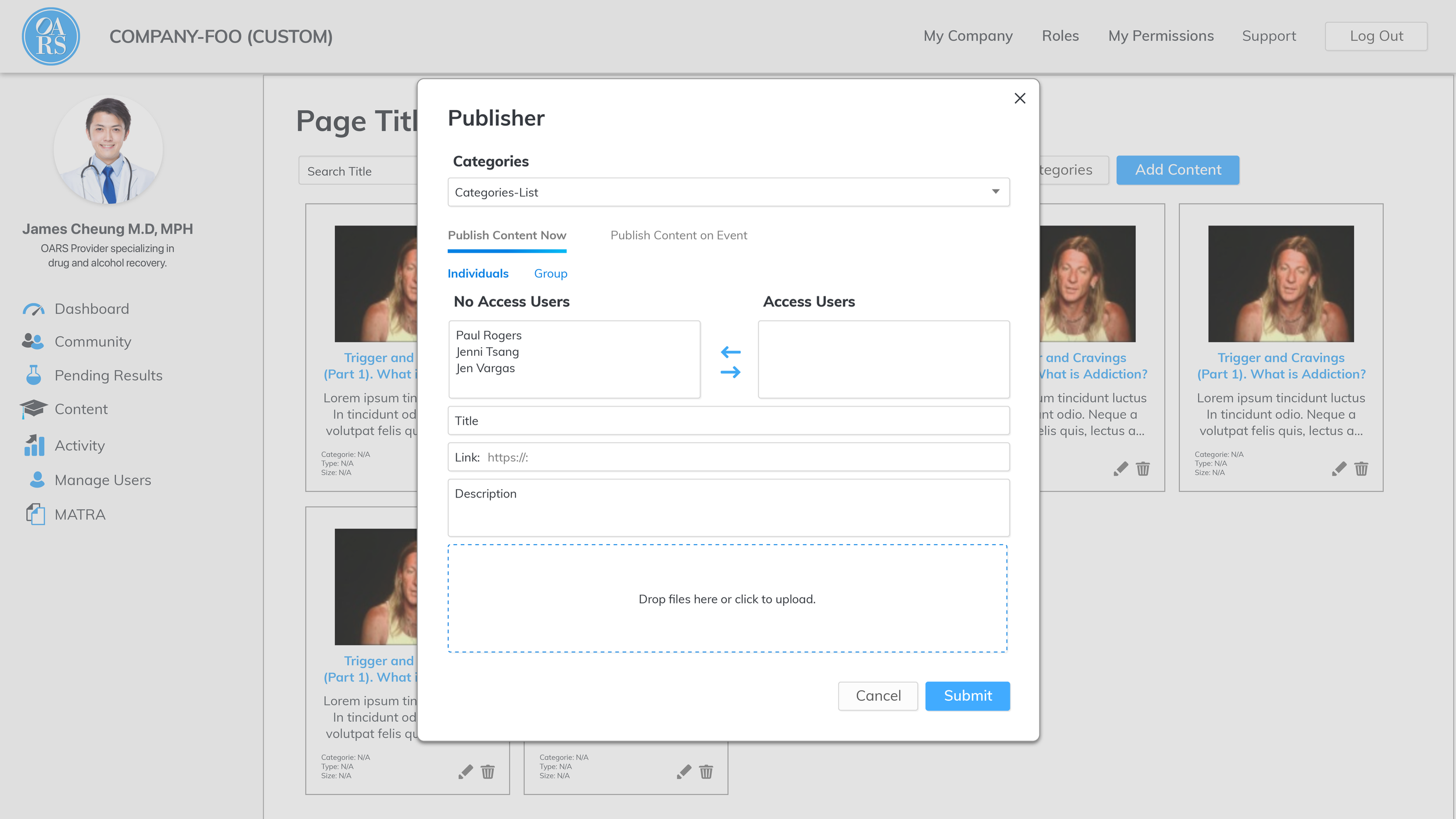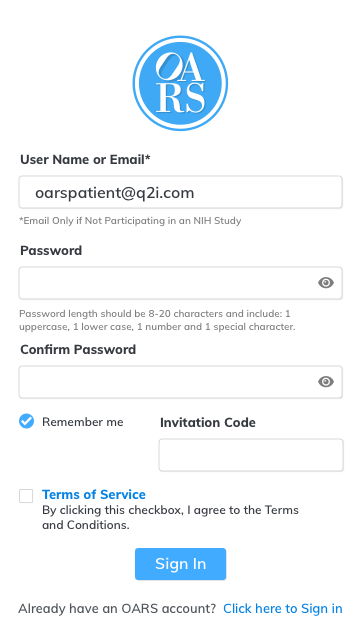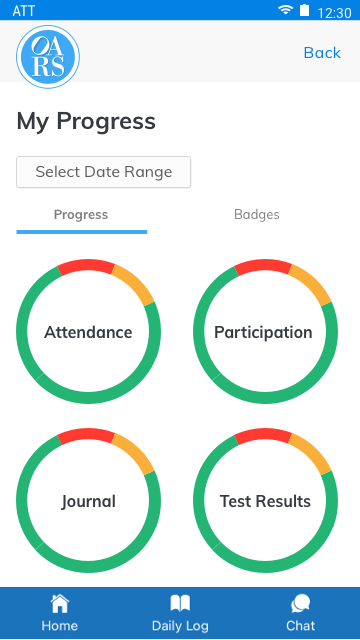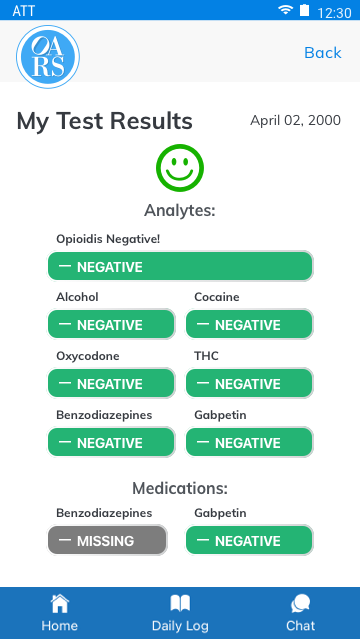Q2i Digital Health Solutions - OARS
OARs - Tools for Medical Providers and Patients
Overview
OARS (Opioid Addiction Recovery Support) is used by providers of MAT (medication-assisted treatment) programs to improve insight into a patient’s recovery progress while promoting ownership and adherence to treatment plans. OARS provides the MAT program with real-time reporting and analytics used to efficiently make data-driven decisions. Providing an increased level of insight into a patient’s progress, OARS identifies outliers and trends and can flag areas of concern for investigation and/or intervention. In addition, OARS provides extensive tools to support patients with their recovery.
Problems to address
As addiction rates continue to skyrocket, drug treatment centers find themselves grappling with overwhelming patient volumes. Taking a wholistic approach is an optimal scenario, but the amount of information and coordination with different factions can be difficult for caregivers to quickly identify areas of treatment that need addressing. The UX needed to be robust enough to handle a large amount of information in a quick glance.
Research Results
Research was gathered from medical partners to define the needs. This data was then converted into personas and scenarios for wireframe use. Per the feedback we created this list of needs:
Healthcare Team Portal Needs
Log and track group attendance details
Log and track observations and meeting participation levels
Manage patient’s feedback and emotions
Manage and send educational materials/content distribution
Manage calendars and appointments
Manage test results data
Send and receive secure messages
Patient Portal Needs
Plot their progress and successes, including input from their healthcare team
Receive educational support and content from the healthcare team
Keep a daily journal, log feelings (shared with the healthcare team or kept private)
Message with their group, anonymous and controllable, give and receive group support in a secure, closed circle
Keep a calendar of appointments with reminders
Securely message with the healthcare team
Goal
As with most tools used in the medical profession, the ability to analyze as much information from a variety of sources in a quick overview is key. Our goal was to take the information required for treatment providers, social services, and patients to create clear dashboards and easily accessed tools for outreach notifications, patient engagement, and testing.
Solutions - Healthcare provider
Using the existing framework we reconfigured and streamlined the pages by add more one click entry points and data visualization for quick reference. High fidelity wireframes were created to be used in a prototype for studies verifying the proof of concept.
Attendance Details: Graphs added to top to show current status of overall patient group. Icons are used to indicate positive, negative and areas that need to be addressed. Results are filtered by all patients, a subset for a specific provider, and archived result pages.
Results Managing: Logging and tracking of test results. Patients with positive tests for opioids are noted in the patient list.
Results Updates: Upon additional feedback or testing results, the provider is able to update and repost the results. Analytics are added inline to show a breakdown of the specific result.
Calendar System: Calendars allow for scheduling new appointments, viewing posting the individual feedback from the patient selected, and test results can be added.
Educational Material: Publishing tool allows the provider the ability upload tools and activities directly for patients to access.
Solutions - Patient
Platform Mobile
Login and Overview pages
Style Guide Creation in Tandem with UX Design
At B. HANSING Design, we understand the importance of creating seamless and visually appealing user experiences. A crucial element of achieving this is the creation of a comprehensive style guide in tandem with UX design. By aligning these two processes, we can ensure consistency in both the visual and interactive aspects of our design solutions.
The Importance of a Style Guide
A style guide serves as a design system that provides guidelines for the visual and interactive elements of a product or service. It establishes consistent branding, typography, color palettes, iconography, and layout principles. A well-crafted style guide ensures a cohesive and unified experience for the end-users, regardless of the platform or device they are using.
Collaboration between Style Guide Creation and UX Design
Creating a style guide in tandem with the UX design process maximizes synergy and efficiency. By involving both the visual designers and UX designers from the beginning, we encourage collaboration and a holistic approach to design.
1. Visual Language:
The visual designers and UX designers work hand in hand to define the visual language and establish the overall design aesthetic. This includes deciding the color scheme, typography, and iconography that best convey the brand personality and create a user-friendly experience.
2. Consistency and Reusability:
The style guide defines reusable components and patterns that can be applied consistently across the entire product. It serves as a reference for designers and developers, ensuring that every element aligns with the established design principles. This consistency allows for smoother handoffs between teams and ensures a seamless experience for users.
3. Accessibility and Usability:
Incorporating accessibility and usability guidelines into the style guide helps design inclusive experiences. Collaboration between UX designers and visual designers allows for the integration of interactive elements and microinteractions that enhance usability and ensure accessibility standards are met.
4. Iterative Design Process:
By intertwining the creation of the style guide with UX design, we embrace an iterative process. Feedback and insights from both designers and usability testing inform the refinement and evolution of the style guide. As the UX design evolves, the style guide adapts in parallel, creating a cohesive and evolving design system.
The Benefits of Tandem Creation
Creating a style guide in tandem with UX design offers several benefits:
Strong Brand Consistency: By aligning the visual and interactive aspects of a design solution, we ensure the brand is consistently represented.
Eff
Tandem creation, which involves collaboration between UX designers and style guide creators, offers numerous benefits for both the user experience (UX) and the overall design consistency within a project. By involving UX designers from the outset, the style guide creators gain valuable insights into the users' needs, preferences, and behaviors. This collaboration ensures that the style guide aligns seamlessly with the UX design, resulting in a cohesive and intuitive user interface. Additionally, the involvement of style guide creators in the UX process allows them to understand the design elements, components, and patterns being used, enabling them to create guidelines that are highly relevant and practical. The result is a streamlined and efficient design process, as well as a style guide that enhances the visual appeal and usability of the final product. Overall, tandem creation bridges the gap between UX and style guide development, empowering designers to create exceptional user experiences while maintaining design consistency.
























